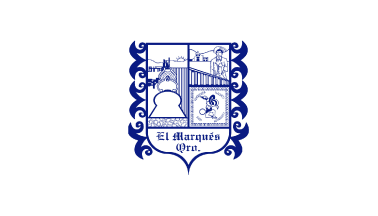
by Daniel Rentería, 8 July 2025, using coat of arms at queretaro.gob.mx
image: [1] from plazadearmas.com.mx

Last modified: 2025-07-18 by daniel rentería
Keywords: el marques | queretaro | bandera municipal y escudo municipal (queretaro) | escudo del municipio (queretaro) | bandera del municipio (queretaro) | héraldica municipal de queretaro |
Links: FOTW homepage |
search |
disclaimer and copyright |
write us |
mirrors

by Daniel Rentería, 8 July 2025, using coat of arms at queretaro.gob.mx
image: [1] from plazadearmas.com.mx
See also:
The flag of El Marqués is white with a blue version of its coat of arms centered upon it.
Daniel Rentería, 8 July 2025
.gif)
image from queretaro.gob.mx
The council simply told me to consult the Municipal Policy of Good Government and Police, which describes its coat of arms in Article 6 (pub. 20 January 2010; but the coat of arms was created earlier): Most versions online are black, but the official image is gray, some are blue. Older versions have the leaves as green and red, like the National Colors. The official image also has its name at the top and a motto "Origen y Destino" at the bottom, but is rarely used. Rather, the name "El Marqués Qro." is found at the bottom most often. Note, the official description has some things that do not really make sense or are incorrect, partially because it is referencing the actual Pan Dulce monument and not the actual coat of arms; from Article 6 (simplified):
It is divided into 2 sections and a rectangle...Inside of the rectangle [left] two motives are observed in the upper prat: the sun which gives heat to the cultivable soil and the incipient industrialization [factory]. In the center a drawing allusive to the "Pan de Dulce" monument constructed in the 17th Century is located, which serves as the boundary with the Municipality of Querétaro and served as boundary marker that determined the adjacent territories of the political division which belonged to the Kingdom of New Spain (Mexico) and Nueva Galicia (Guadalajara, Jalisco)...it gives its name to the fact it has the sameness to a replica of the miniatures of fruit and vegetables made of sugar which were given as a dessert to indigenes invited by Conín [Indian conquistador]; it is a monolith which is composed of four bodies or sections: the first is the basement, the second has serpent forms which go to unite by their heads formed by two snails; in the third body the serpent forms originate in the center of a shell...[to the right is a field for agriculture and a stone path under] In the upper part of the upper square "La Iglesia Chiquita" is represented, considered the oldest Catholic temple of Querétaro. In the lower part the figure of Don Juan Antonio de Urrutia y Arana, Marqúes [or Marquess] of the Villa del Villar y del Águila [name corrected*] over monumental arches of the city of Querétaro. In the lower section, an Otomí ball player is represented and to his sides the words: "Tlachco, Ndamaxei, Xico y Querenda", names with which it [the game] was called "place where the ball game is played.
Daniel Rentería, 8 July 2025
Anything below this line was not added by the editor of this page.